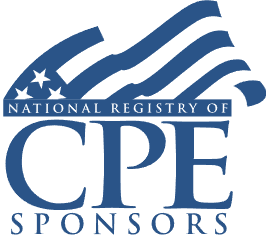Tax Reform One Year Later: Maximize Benefits and Minimize Burdens
Incorporating New Provisions and Regulatory Uncertainty in Year-End Tax Planning

Course Details
- smart_display Format
On-Demand
- signal_cellular_alt Difficulty Level
Intermediate
- work Practice Area
Tax Preparer
- event Date
Wednesday, December 12, 2018
- schedule Time
1:00 PM E.T.
- timer Program Length
110 minutes
-
BARBRI is a NASBA CPE sponsor and this 110-minute webinar is accredited for 2.0 CPE credits.
-
BARBRI is an IRS-approved continuing education provider offering certified courses for Enrolled Agents (EA) and Tax Return Preparers (RTRP).
-
Live Online
On Demand
This course will offer an in-depth evaluation of the “winners and losers” of the tax reform law, one year after its passage. The panel will offer planning tools to take advantage of the more advantageous terms in the bill and mitigate potential tax issues caused by some of the problematic provisions of the law.
Description
A year after the passage of the tax reform law, many of the provisions of the law continue to challenge tax professionals. As advisers enter into the first end-of-year planning season with the tax reform law’s provisions in place, advisers should understand which classes of taxpayers are emerging as relative “winners” and “losers” under tax reform.
Tax reform radically altered the tax landscape for virtually every U.S. taxpayer. The law lowered overall rates, eliminated many deductions, compressed income brackets, and introduced some new complexities into the tax planning and compliance processes. While many taxpayers saw at least a temporary reduction in their overall tax burden, some taxpayers experienced net tax increases. Further complicating matters is a lack of guidance from the IRS on some of the more challenging aspects of the law, leaving planners with open questions as to structuring tax matters for impacted taxpayers.
Tax advisers performing year-end planning for taxpayers holding partnership interests, foreign assets, and certain types of property will face new issues in advising clients on steps to lower their overall tax liability and structure their affairs to make tax compliance less costly and less complicated. Critical to this task is recognizing those provisions that create new liabilities and reporting requirements, and emerging approaches to managing them.
Listen as our experienced panel provides a practical guide to evaluating “winners and losers” from the tax reform law in the context of creating end-of-year tax plans.
Outline
- Tax reform changes that have emerged as having the most significant impact on individual taxpayers
- Partnership and pass-through entity planning
- Principal steps to manage new foreign tax payment and reporting obligations under tax reform
- Estate planning implications
- Planning uncertainties in light of sunset provisions as well as potential political changes
Benefits
The panel will discuss these and other critical issues pertaining to the impact of tax reform one year after passage:
- How does tax reform change year-end tax planning considerations?
- Which classes of taxpayers are most impacted by the tax law provisions, and how can year-end planning mitigate any negative effect?
- Ensuring that new international tax provisions and related reporting obligations are taken into account in year-end plans, and beyond
- Impact of tax reform’s increased standard deduction on charitable planning
- Year-end strategies to adjust net operating loss treatment
NASBA Details
Learning Objectives
After completing this course, you will be able to:
- Identify provisions in the tax reform law that result in providing new advantages or burdens to certain types of taxpayers
- Recognize new end-of-year planning steps and structures necessitated by the tax reform law
- Design strategies to manage new tax liability and reporting obligations created by tax reform
- Incorporate possibility of sunset or reversal of certain provisions in structuring end of year plans
- Field of Study: Taxes
- Level of Knowledge: Intermediate
- Advance Preparation: None
- Teaching Method: Seminar/Lecture
- Delivery Method: Group-Internet (via computer)
- Attendance Monitoring Method: Attendance is monitored electronically via a participant's PIN and through a series of attendance verification prompts displayed throughout the program
- Prerequisite: Three years+ business or public firm experience at mid-level within the organization, preparing complex tax forms and schedules, supervising other preparers/accountants. Specific knowledge and understanding of the major provisions of the 2017 Tax Cuts and Jobs Act, as well as experience in creating year-end tax plans and projections for individual and partnership taxpayers.

Strafford Publications, Inc. is registered with the National Association of State Boards of Accountancy (NASBA) as a sponsor of continuing professional education on the National Registry of CPE Sponsors. State boards of Accountancy have final authority on the acceptance of individual courses for CPE Credits. Complaints regarding registered sponsons may be submitted to NASBA through its website: www.nasbaregistry.org.

Strafford is an IRS-approved continuing education provider offering certified courses for Enrolled Agents (EA) and Tax Return Preparers (RTRP).
Unlimited access to premium CLE courses:
- Annual access
- Available live and on-demand
- Best for attorneys and legal professionals
Unlimited access to premium CPE courses.:
- Annual access
- Available live and on-demand
- Best for CPAs and tax professionals
Unlimited access to premium CLE, CPE, Professional Skills and Practice-Ready courses.:
- Annual access
- Available live and on-demand
- Best for legal, accounting, and tax professionals
Unlimited access to Professional Skills and Practice-Ready courses:
- Annual access
- Available on-demand
- Best for new attorneys
Related Courses
Recommended Resources
How CPE Can Bridge the Gap Between What You Know and What You Need to Know
- Career Advancement
